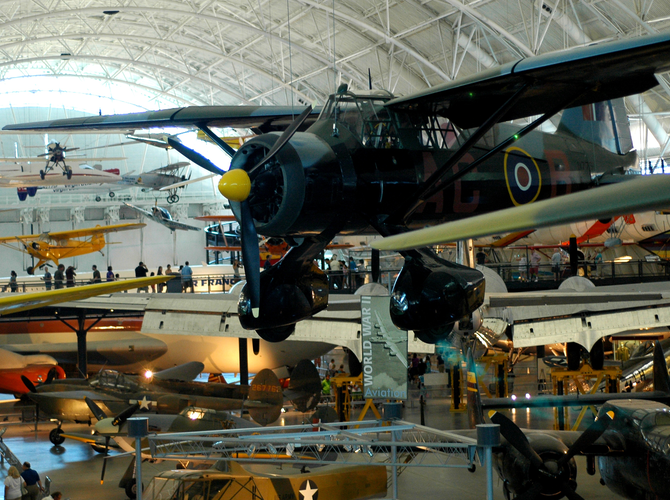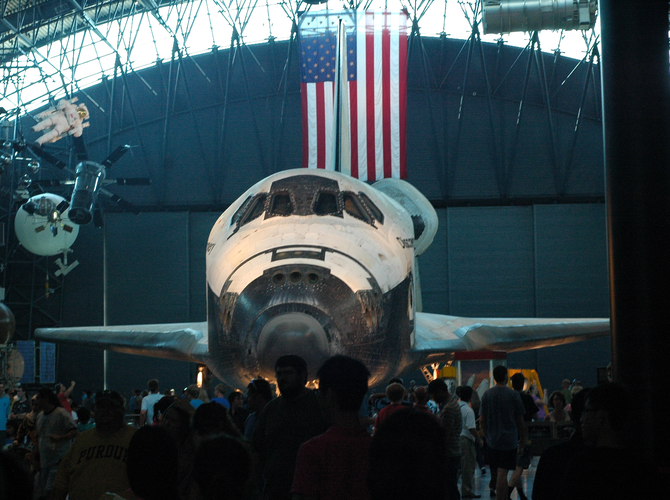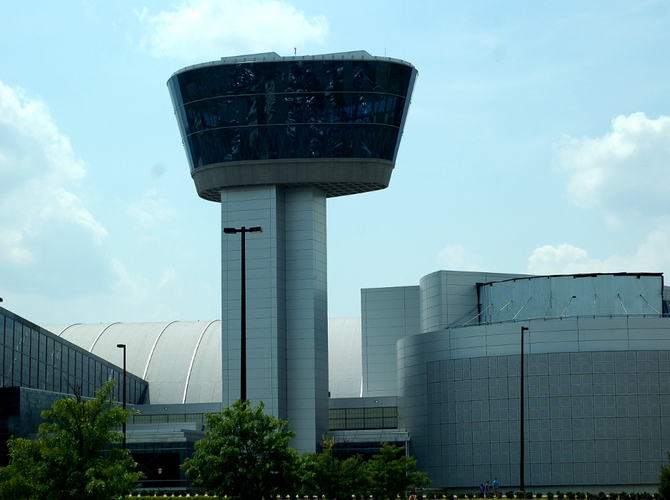National Air and Space Museum - Udvar-Hazy Center
What is the National Air and Space Museum's Udvar-Hazy Center?
The Udvar-Hazy Center is part of the Smithsonian Institution's National Air and Space Museum. The center, located near Dulles International Airport in Northern Virginia, houses a large portion of the institution's air and space collection including a space shuttle, Blackbird, and aircraft from all eras of flight.
What Exhibits and Highlights are at the Udvar-Hazy Center?
The museum features many permanent exhibits:
-
Aerobatic Flight: Aircraft aren't just about getting from one place to another. Throughout the history of flight there has been an aspect of fun, art, and competition. The aerobatic flight exhibit captures this with biplanes and other racing and aerobatic aircraft from the 1930's and later.
-
Applications Satellites: The Space Age wasn't just about getting people into space. Satellites looking back at us and providing communications, photography, and weather analysis have greatly expanded our abilities. This exhibit includes satellite models, a film return capsule, and a rocket booster used to get these devices into orbit.
-
Business Aviation: Most of use are familiar with giant commercial airports and aircraft, but when business leaders need a flexible way to get around they often use a class of aircraft designed for business needs. The Udvar-Hazy center's display features a Lear Jet 23.
-
Cold War Aviation: Aviation was a critical part of the arms race of the Cold War. Aircraft were used for spying, carrying explosives, and playing a vital part in potential conflict. The exhibit features a Lockheed SR-71 Blackbird, the world's fastest jet aircraft.
-
Commercial Aviation: For most people, air flight is about travel. Explore some of the aircraft that evolved commercial travel, including the supersonic Concorde, and a Boeing 367-80.
-
General Aviation: Flying can be used for recreation, personal travel, sightseeing, or medical evacuation. This activity is considered general aviation, and sports a unique type of functional aircraft. The exhibit showcases a Piper J-3 Cub, Grumman G-22 Gulfhawk II, and more.
-
Human Spaceflight: Spaceflight was a major achievement of the 20th century, and the Udvar-Hazy Center features some treasures that got us there. The Space Shuttle Discover is the highlight of the exhibit. A 39-time veteran of space flight, the shuttle spent 365 days in space. Also see a Mercury Capsule and many other items involved in manned space travel.
-
Interwar Military Aviation: After World War I, military aircraft continued to evolve. These propeller-based aircraft from the 1920's and 1930's fall in that middle ground between the two world wars.
-
Korea and Vietnam Aviation: Learn about the role played by aviation during these two Asian conflicts. During this era the helicopter played a significant role, and advanced aircraft deterred other world powers from making these wars into worldwide wars.
-
Modern Military Aviation: Today's aircraft are the most advanced ever, with pinpoint targeting capabilities, vertical takeoff, and improvements in speed, agility, and more. The Lockheed Martin X-35B STOVL headlines this exhibit.
-
Pre-1920 Aviation: The early days of flight were a new opportunity to grow an incredible new field. The exhibit shows off the Caudron G-4 (an early bomber), and some early fighter designs.
-
Rockets and Missiles: Missiles today can be launched and fly autonomously to their destination. Rockets launch satellites and humans into space. These flying explosives and propulsion machines have evolved alongside the airplane. This exhibit features all sizes of missiles and rockets, including the Loon Missile, and an early liquid-propellant missile, the Redstone Missile.
-
Space Science: As humans expand the ability to explore space, we have turned to studying the rest of the solar system and the universe. See a full-scale prototype of the Mars Pathfinder Lander and Sojourner Rover, and an engineering model of a probe designed to explore Venus.
-
Sport Aviation: Flying for fun has been around as long as human flight. See gliders, and leisure aircraft with this exhibit.
-
Transformers: More than Meets the Eye!: The museum features some historic Transformers toys, and some aircraft related to the toys. The museum's Lockheed SR-71 Blackbird was used in the Transformers film.
-
Ultralight Aircraft: Ultralight aircraft are used for scientific and recreational purposes. See the Cosmos Phase II, used to lead migrating birds, and other aircraft in this exhibit.
-
Vertical Flight: Airplanes aren't alone in the air. Helicopters also play important roles in our aircraft. See civilian helicopters and other vertical-takeoff aircraft in this section of the museum.
-
World War II Aviation: Aircraft played a huge part in World War II, and many of the airplanes involved can be found at the museum. The collection is highlighted by a Boeing B-29 Superfortress, the Enola Gay. This aircraft dropped the first combat atomic weapon on Hiroshima, Japan, leading to the end of the war.
-
World War II German Aviation: Germany shocked the world with Blitzkrieg, or lightening war. Air power played a critical part in this aggressive strategy, and German aviation continued to play an important role in the war. Several of the aircraft models used in the war can be found here.
The museum also runs special exhibitions throughout the year. For a current listing, see the museum's listing of current exhibitions.
Many permanent and special exhibits are found at the National Air and Space Museum's DC location on the National Mall.
What else can be found at the Udvar-Hazy Center?
The Udvar-Hazy center features a few other attractions:
-
The Donald D. Engen Tower: Visitors can observe flights taking off and landing at nearby Dulles International Airport, and can experience what it's like to be in a commercial control tower, modeled off the control tower at Newark airport in New Jersey.
-
Airbus IMAX Theater: See aviation themed educational videos in an IMAX theater.
-
Flight Simulators: Experience flight in these simulators, providing the experience of flying without leaving the museum.
When is the Udvar-Hazy Center Open?
- The Smithsonian Institution's Museums are open daily from 10 a.m. to 5:30 p.m.
- Close extended until 6:30 p.m. some days (details)
- Closed December 25, and for some weather related events.
Where is the Udvar-Hazy Center?
The Udvar-Hazy Center is located in Chantilly, VA near Dulles International Airport.
How can I get to the Udvar-Hazy Center?
The facility is located in Chantilly, VA near Dulles International Airport. Driving is the most convenient way to get to the museum; other options would include taxi from the airport or other nearby location (see Dulles International Airport for information about travel to Dulles airport). See the Smithsonian Institution's website for driving directions here.
What does it cost to visit the Udvar-Hazy Center?
As with other Smithsonian Institution museums and galleries, there is no cost for admission to the National Air and Space Museum. There is a $15 fee to park at the museum, and some attractions, including the IMAX theater and flight simulators have an additional fee.
Where can I learn more about the Udvar-Hazy Center?
Learn more at http://airandspace.si.edu/.


